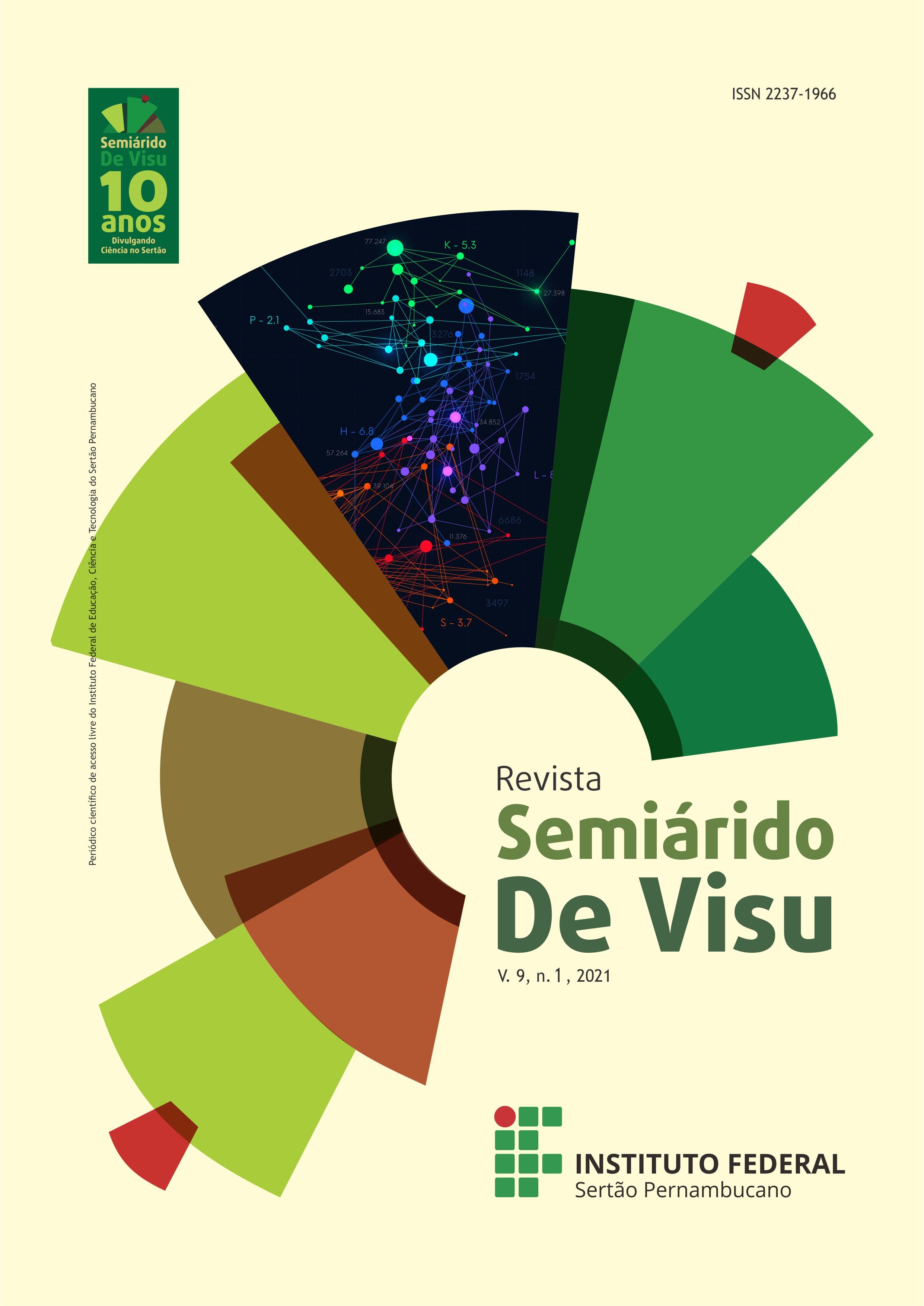Um Modelo de Rede Neural Profunda para Previsão da Pandemia do SARS-COV-2 no Brasil
Visualizações: 611DOI:
https://doi.org/10.31416/rsdv.v9i1.21Palavras-chave:
Redes Neurais Profundas, Séries Temporais, Previsão, COVID-19Resumo
A Organização Mundial de Saúde declarou a doença do coronavírus 2019 (COVID-19) como uma pandemia sem precedentes nos tempos modernos. O agente etiológico da COVID-19 é um novo coronavírus conhecido como \emph{severe acute respiratory syndrome coronavirus 2} (SARS-Cov-2), que tem causado complicações de diferentes gravidades no sistema respiratório humano e, consequentemente, sobrecarregando os sistemas de saúde mundiais devido à demanda excessiva de internações em unidades de terapia intensiva. Desta forma, devido a ausência de remédios efetivos e vacinas licenciadas para combater a COVID-19 e suas variantes, medidas de quarentena e distaciamento social têm sido empregados na tentativa de retardar a disseminação acelerada da COVID-19. No entanto, tais medidas causaram uma forte retração em diversas atividades econômicas. Neste cenário, prever a dinâmica da pandemia é essencial para nortear a estratégia para lidar simultaneamente com o crescimento da demanda por suporte à saúde e os reflexos na economia. Portanto, este trabalho apresenta um modelo de rede neural profunda projetado por um processo de aprendizagem baseado em gradiente para prever o a disseminação da COVID-19, utilizando uma abordagem baseada em séries temporais. A fim de avaliar o desempenho preditivo do modelo, foram utilizadas séries temporais da COVID-19, com frequência diária, no Brasil. Os resultados obtidos mostram efetividade, em termos de desempenho preditivo, do modelo proposto para estimar a dinâmica da pandemia da COVID-19.
Referências
ARAUJO,R.deA.etal.Adeepincreasing-decreasing-linearneuralnetworkfor?nancialtimeseriesprediction. Neurocomputing,v.347,p.59–81,2019.
AYITTEY, F. K. et al. Economic impacts of wuhan 2019-ncov on china and the world.J Med Virol, v. 5, n. 92, p.473–475, 2020.
BENVENUTO,D.etal.Applicationofthearimamodelonthecovid-2019epidemicdataset.DatainBrief,v.29, p.105340,2020.
BOX, G. E. P.; JENKINS, G. M.; REINSEL,G. C. TimeSeriesAnalysis: ForecastingandControl. Third.New Jersey: PrenticeHall,1994.
CAO, J. et al. Clinical features and short-term outcomes of 18 patients with corona virus disease 2019 in intensivecare unit.Intensive Care Medicine, In Press, 2020.
CHENG-I, W. et al. Sars-cov-2, covid-19 and inherited arrhythmia syndromes.Heart Rhythm, In Press, 2020.
CLEMENTS, M. P.; HENDRY, D. F. On the limitations of comparingmean square forecasterrors. Journalof Forecasting,v.12,n.8,p.617–637,1993.
DINIZ, N.; LIMA, F. G.; FILHO, A. C. da S. The impact of the hurst window in the financial time series forecast:an analysis through the exchange rate.Review of Business Research, v. 12, p. 27–33, 2012.
DOZAT,T.Incorporatingnesterovmomentumintoadam.In: .[S.l.: s.n.],2016.
DUCHI, J. C.; HAZAN, E.; SINGER, Y. Adaptive subgradient methods for online learning and stochastic optimization.J.Mach.Learn.Res.,v.12,p.2121–2159,2011.
FRASER, A.; SWINNEY, H. Independentcoordinatesfor strangeatractorsfrom mutual information.Physical ReviewA,v.33,n.2,p.1134–1140,1986.
GAO,G.F.From“a”to“z”: attacksfromemergingandre-emergingpathogens.Cell,v.172,p.1157–1159,2018.
HANN, T. H.; STEURER, E. Much ado aboutnothing? exchangerate forecasting: Neural networksvs. linear modelsusingmonthlyandweeklydata.Neurocomputing,v.10,p.323–339,1996.
HE,F.;DENG,Y.;LI,W.Coronavirusdisease2019(covid-19): Whatweknow? Journalofmedicalvirology,In Press,2020.
HURST, E. Longtermstoragecapacityof reservoirs.TransactionsoftheAmericanSocietyofCivilEngenieers, v.116,p.770–799,1951.
IMAI,N.etal.Report1:Estimatingthepotentialtotalnumberofnovelcoronavirus(2019-ncov)casesinwuhancity. https://www.imperial.ac.uk/mrc-global-infectious-disease-analysis/covid-19/report-1-case-estimates-of-covid-19/, 2020.
IOFFE,S.;SZEGEDY,C.Batchnormalization: acceleratingdeepnetworktrainingbyreducinginternalcovariate shift.InternationalConferenceonInternationalConferenceonMachineLearning,v.37,p.448–456,2015.
KINGMA, D. P.; BA, J.Adam: A Method for Stochastic Optimization. 2014.
LAI, C. et al. Severe acute respiratory syndrome coronavirus 2 (sars-cov-2) and coronavirus disease-2019 (covid-19): Theepidemicandthechallenges.InternationalJournalofAntimicrobialAgents,InPress,2020.
LAZZERINI,M.; PUTOTO, G. Covid-19 in italy: momentousdecisions and many uncertainties.LancetGlob Health,InPress,2020. LI,L.etal.Propagationanalysisandpredictionofthecovid-19.InfectiousDiseaseModelling,v.5,p.282–292, 2020.
MENEZES,J. M. P.; BARRETO, G. A. Long-termtimeseries predictionwith thenarx network: An empirical evaluation.Neurocomputing,v.71,n.16-18,p.3335–3343,2008.
MUNSTER, V. J. et al. A novelcoronavirusemergingin china- key questionsfor impactassessment. TheNew Englandjournalofmedicine,InPress,2020.
NAIR, V.; HINTON, G. E. Rectified linear units improve restricted boltzmann machines.ICML, p. 807–814, 2010.
PARMET, W. E.; SINHA, M. S. Covid-19 - the law and limits of quarantine.N Engl J Med, v. 382, p. 1–28, 2020.
PENG, L. et al.Epidemic analysis of COVID-19 in China by dynamical modeling. 2020.
PETROPOULOS, F.; MAKRIDAKIS, S. Forecasting the novel coronaviruscovid-19.PLOS ONE, v. 15, n. 3, p.1–8,032020.
PRECHELT,L.Proben1: AsetofNeuralNetworkBenchmarkProblemsandBenchmarkingRules.[S.l.],1994.
REDDI,S.J.;KALE,S.;KUMAR,S.OntheConvergenceofAdamandBeyond.2019.
RODA, W. C. et al. Why is it difficult to accurately predict the covid-19 epidemic?Infectious Disease Modelling,v. 5, p. 271 – 281, 2020.
ROSA, S. G. V.; SANTOS, W. C. Clinical trials on drug repositioning for covid-19 treatment. Pan American JournalofPublicHealth,InPress,2020.
SHE,J.etal.2019novelcoronavirusofpneumoniainwuhan,china: emergingattackandmanagementstrategies. ClinTranslMed,v.9,n.1,p.1–19,2020.
SHEN, M. et al. Modelling the epidemictrend of the 2019 novel coronavirusoutbreak in china.bioRxiv, Cold SpringHarborLaboratory,2020.
SOHRABI,C.etal.Worldhealthorganizationdeclaresglobalemergency: Areviewofthe2019novelcoronavirus (covid-19).InternationalJournalofSurgery,v.76,p.71–76,2020.
SRIVASTAVA, N. et al. Dropout: a simple way to prevent neural networks from overfitting.Journal of MachineLearning Research, v. 15, n. 1, p. 1929–1958, 2014.
STOJANOVIC, M. B. et al. Amethodologyfor trainingset instanceselection using mutualinformationin time seriesprediction.Neurocomputing,v.141,p.236–245,2014.
SUTSKEVER, I. et al. On theimportanceof initialization andmomentumin deep learning.In: Proceedingsof the 30th InternationalConferenceon MachineLearning. Atlanta, Georgia, USA: [s.n.], 2013. (Proceedingsof MachineLearningResearch,3),p.1139–1147.
TANG,B.etal.Anupdatedestimationoftheriskoftransmissionofthenovelcoronavirus(2019-ncov).InfectDis Model,v.5,p.248–255,2020.
TANG, B. et al. Estimation of the transmission risk of the 2019-ncov and its implication for public health interventions.JournalofClinicalMedicine,InPress,2020.
TIELEMAN, T.; HINTON, G. Lecture 6.5 - RmsProp: Divide the gradient by a runningaverageof its recent magnitude.2012.COURSERA:NeuralNetworksforMachineLearning.
VAISHYA, R. et al. Arti?cial intelligence (ai) applications for covid-19 pandemic. Diabetes & Metabolic Syndrome: ClinicalResearch&Reviews,v.14,n.4,p.337–339,2020.
WHO.Coronavirus disease 2019 (COVID-19): Situation Report - 51. [S.l.], 2020.
WU, C. et al. Sars-cov-2, covid-19 and inherited arrhythmia syndromes.Heart rhythm, In Press, 2020.
WU, J. T.; LEUNG, K.; LEUNG, G. M. Nowcasting and forecasting the potential domestic and internationalspread of the 2019-ncov outbreak originating in wuhan, china: a modelling study.The Lancet, v. 395, n. 10225, p.689–697, 2020.
WU, Z.; MCGOOGAN, J. M. Characteristics of and important lessons from the coronavirus disease 2019(covid-19) outbreak in china: Summary of a report of cases from the chinese center for disease control andprevention.JAMA, v. 323, n. 13, p. 1239–1242, 2020.
YOU, C. et al. Estimation of the time-varying reproduction number of covid-19 outbreak in china.medRxiv, ColdSpring Harbor Laboratory Press, 2020.
ZEILER, M. D.ADADELTA: An Adaptive Learning Rate Method. 2012.
ZHAO,S.etal.Estimatingtheunreportednumberofnovelcoronavirus(2019-ncov)casesinchinainthe?rsthalf ofjanuary2020: Adata-drivenmodellinganalysisoftheearlyoutbreak.J.Clin.Med,InPress,2020.
ZHOU,P.etal.Discoveryofanovelcoronavirusassociated with therecentpneumoniaoutbreakin humansand itspotentialbatorigin.bioRxiv,InPress,2020.
ZHU,N. etal. Anovelcoronavirusfrompatientswith pneumoniain china, 2019.NEnglJMed, v.382, n. 2, p. 727–733,2020.















